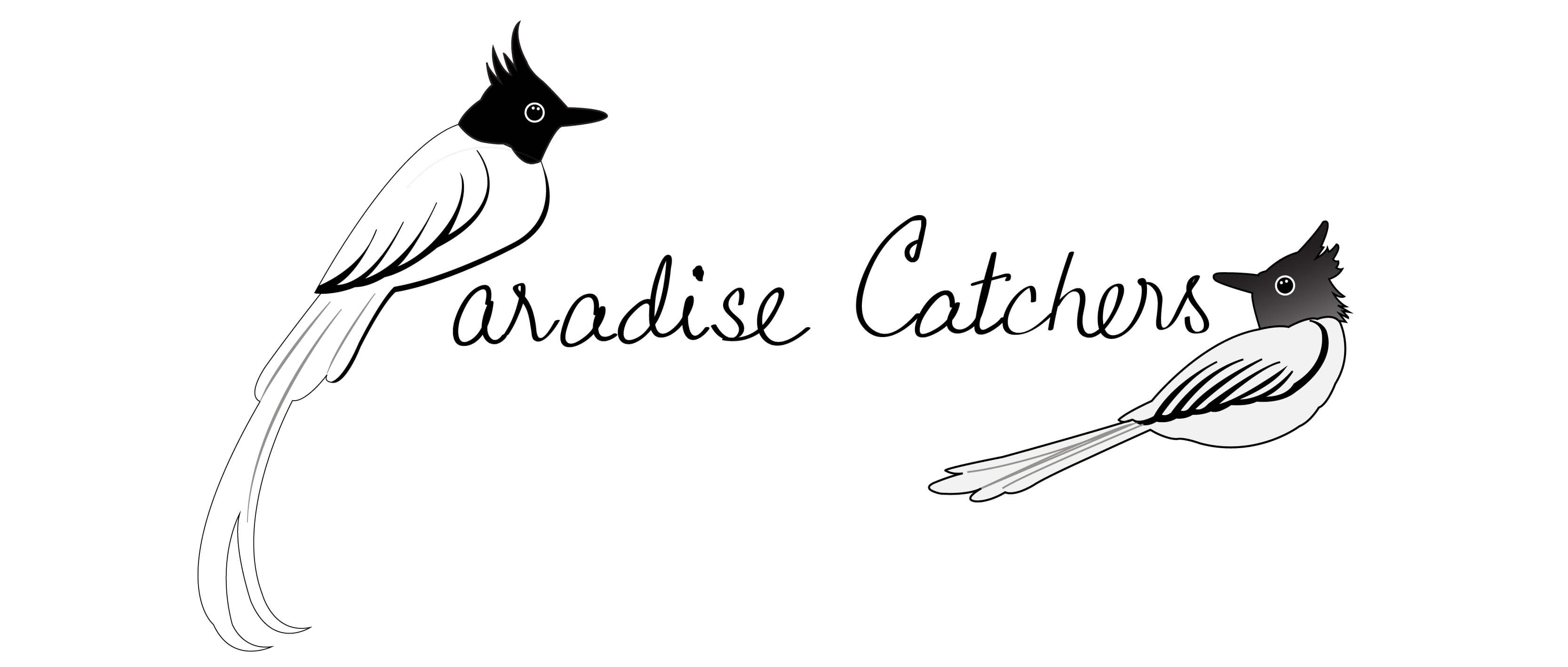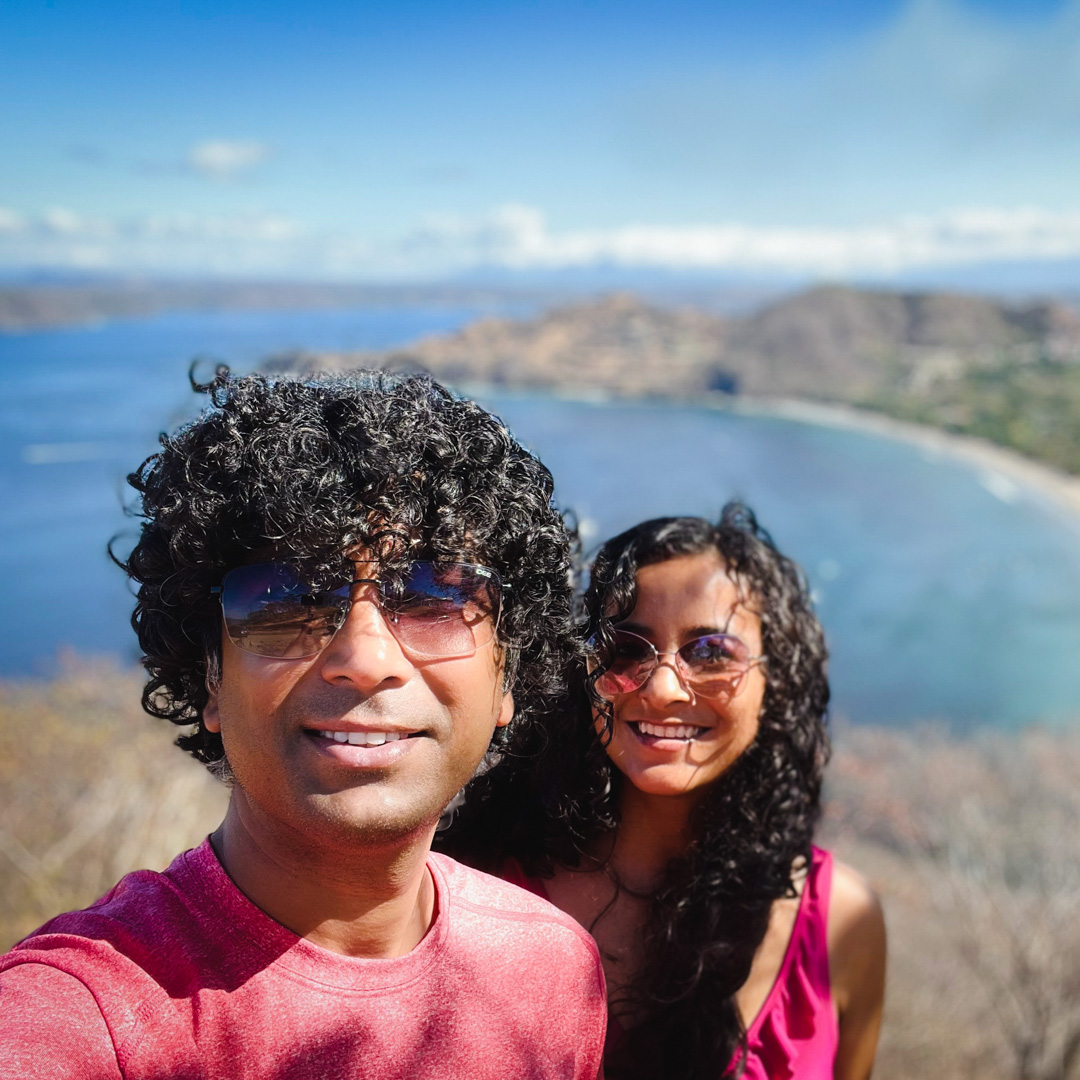“Do not skip El Salvador”, says the country’s tourism tagline. We could not agree more.
Often tossed out from the tourist trail of Central America, we believe El Salvador deserves more attention. This small country is blessed with a Pacific coastline consisting of incredible surfing beaches, idyllic mountain towns and excellent coffee production, volcanoes, lakes and waterfalls, and a rich history spanning from the ancient Mayans to colonial rule to now, groundbreaking modern decisions that catch the attention of the world.
But traveling in El Salvador is not just about checking off a list of places to see. Whether gobbling up pupusas or withdrawing Bitcoin from ATMs or experiencing the warm hospitality of the Salvadorans, there are several unique travel memories to take back home from here.
We have created this 2 week El Salvador itinerary that allows you to explore the country’s best highlights, ideal for first time visitors. In this article, we are going to share a day wise travel plan, and also address some other key questions and logistics that will help you plan the perfect trip of 14 days in El Salvador.
Grab a coffee, and start reading. Remember to take note and bookmark pages for later.
As Amazon Associate we earn from qualifying purchases. Thanks for supporting Paradise Catchers.
Watch this video about our first impressions of traveling in El Salvador:
Things to Know about El Salvador
- International Airport: San Óscar Arnulfo Romero y Galdámez International Airport
- Currency: US Dollars. Also, Bitcoin is a legal tender.
- Local Language: Spanish
- Potable Tap Water: No
- Country Capital: San Salvador
- Population: More than 6 million. Most densely populated country in Central America.
El Salvador Itinerary Planning Resources:
- Top Activities and Tours:
- Find Accommodation:
- Cities: San Salvador | Suchitoto | Santa Ana
- Mountains: Juayua | Concepcion de Ataco
- Beaches: El Zonte | El Sunzal
- Best Way to Get Around: Rent A Car
- Shop for your El Salvador Packing List on Amazon
Is El Salvador Safe?
Then and Now
Not too long ago, El Salvador used to hold the reputation of being one of the most dangerous places on earth, most crimes cropping up from gang violence.
However, in the recent years, the government has taken active (some may even term “stern”) measures to crack down on the gangs, making the country feel a safer place, for visitors and residents alike. And the crime rate statistics do reflect this drastic change.
Transformation
This is also visually evident as in some places, you may come across armed military patrolling important spots. We had the chance to check with some newly made Salvadoran friends about how they felt about such military presence.
Their responses reflected confidence, safety and gratitude, because growing up, it was not normal for them to hang out on the streets at night just like that, but now it is a real possibility.
So, in case you feel weird about gunned men strolling near where you are, please don’t. They are working towards erasing decades worth of bad reputation.
Our Personal Experience
We traveled in El Salvador for 1 month, backpacking all across the country. We used public transport, walked on streets – during the day AND at night, and even hitchhiked on couple of occasions.
Thankfully, not just did we feel safe in most of the places, but also felt extremely welcomed by the people of El Salvador. Oh the number of tales we can tell about how the Salvadorans went out of their way just to proactively help or guide two random people (us) on the street!
Related Story: That time when we got stuck in an unwanted situation in El Salvador and some Salvadorans came together to assist us – read the full story here. You can also watch the video.
Do Not Forget
Having said that, please do follow the precautions as you would while traveling anywhere else. Check with your accommodation host about local safety and things not to do, take care of your belongings, do not flash expensive things, be aware of your surroundings, and follow your instincts.
How to Get Around in El Salvador?
Unlike Costa Rica, the public transport network in El Salvador is excellent. There is no metro/subway system, and the buses are far from fancy. The buses are slow, have multiple stops along the way, but they do the job of getting you from one place to another, connecting almost all cities and towns all over the country.
If you are backpacking in El Salvador, these buses are your best bet for getting around. Most rides cost between 0.50-2.00 USD. Now, if you have a big backpack that’s going to occupy a seat, some short distance routes may charge you double.
However, if you want to maximize what you can see or do during your 14 days in El Salvador, we recommend renting a car. This way, you will save a ton of time on ground transportation, instead of relying on bus schedules. You will also have the flexibility of creating your custom route, thereby optimizing your El Salvador itinerary.
You can rent the car at the airport upon arrival, and return it at the same spot on the day of your departure. Check Discover Cars to compare and select from the best deals across different car rental companies in El Salvador.
2-Week El Salvador Itinerary: City, History, Volcano, Mountains, Beach
This itinerary is perfect for first time visitors as it gives glimpses of the diverse highlights of El Salvador in 14 days. From big capital city to old colonial towns, from volcanoes and ancient ruins to coffee plantations and mountains, from lakes and hot springs to waterfalls and beaches, there’s a lot to see and do in El Salvador.
We have designed this 2-week El Salvador itinerary assuming you fly in to El Salvador at the international airport, rent a car for getting around and then fly out from the same airport after dropping the rental car.
However, if you plan on availing public transport for seeing all the places on this itinerary, we suggest you to increase the length of your stay in El Salvador.
And, if you do need to stick to 2 weeks in El Salvador but not rent a car, you can book tours that include ground transportation. This way, you will avoid the stress of driving in a foreign country but still get maximum coverage of places and activities.
Day 1: Arrive at San Salvador + City Tour
The first 8 days of this El Salvador itinerary will take you to multiple destinations, changing bases. However, if you prefer a more stationary base and still see as much, we are going to share an alternative itinerary as well. Keep reading.
After arriving at the El Salvador international airport, head straight to San Salvador. Why not start exploring the country from its capital city?
Day: Historic Center of San Salvador
Steeped in history and culture, there are quite a few spots to check out in the city center. Here are some places to add to your self-guided walking route of San Salvador, starting at the Morazan Plaza.
- Morazan Plaza: A vibrant gathering place with a statue of Francisco Morazan. This is your launchpad for exploring the historic center of San salvador.
- National Theater: An architectural gem. Take a guided tour of the theater to learn about this piece of history and culture, or even catch a live performance, of show schedules align with your itinerary.
- Metropolitan Cathedral: The main cathedral in the historic center with grand architectural style.
- National Palace: A grand building with 4 distinctly colored main rooms and a hundred other rooms. Offices for various government purposes, the palace is now a National Monument, open for visitors for guided tours.
- Gerardo Barrios Plaza: Lively public square next to the palace and the cathedral, with monument of former President Gerardo Barrios’s statue as a focal attraction.
- Liberty Plaza: One block down from Gerardo Barrios plaza, this is another plaza where people come together for jolly gatherings. We saw groups of smiling and dancing men and women when we visited.
- El Rosario Church: Unique architecture and magical play of lights through the stained glass windows, this is one of the most beautiful churches we have seen.
After or while checking out these iconic places in the historic center of San Salvador, take a break and grab lunch at one of the fine restaurants around.
If you prefer to get a guided break down of the historical interests in a city, check out this half-day city walking tour. It takes you to the important landmarks and plazas of the historic center, and also includes pupusas tasting!
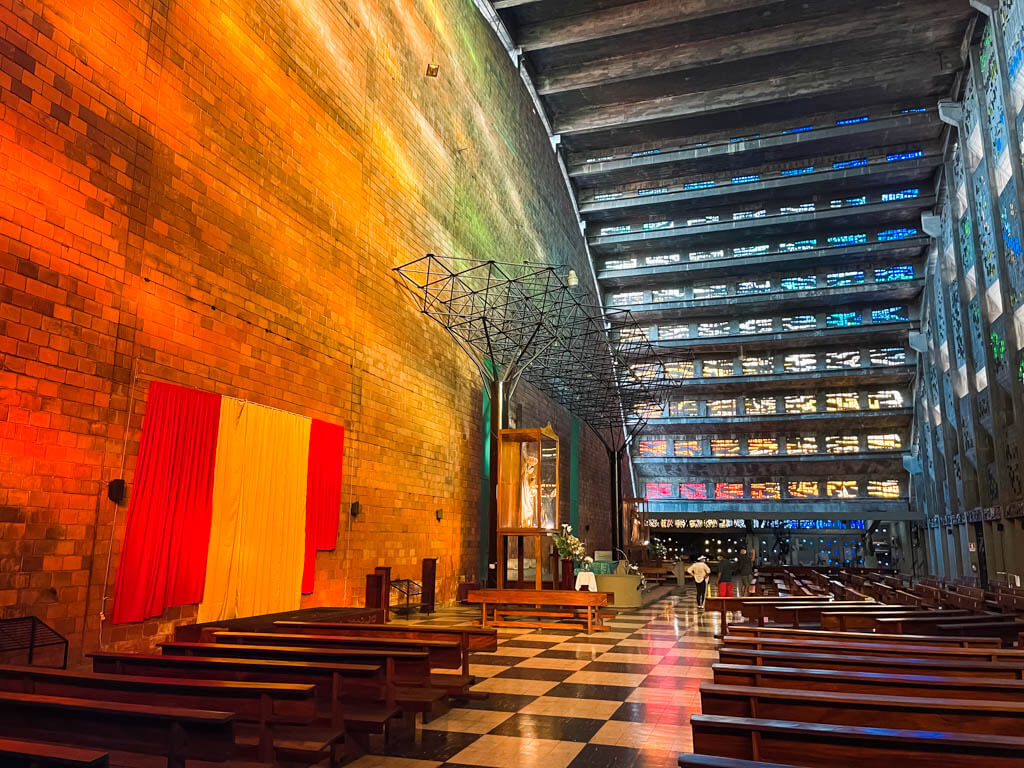
Late Afternoon: Artisanal Market
If you are up for more exploration, get to another part of the city, to the Mercado Nacional de Artesanias. It is a nice colorful spot where you can walk along alleys, browse trinkets and knick-knacks at the small shops, and shop for your souvenirs.
Be mindful that this artisanal market is for tourists, so you need to be careful about the prices you are asked to pay.
On the way to the artisanal market, you can also check out the Monument to the Divine Savior of the World. It is a tall monument of a concrete based pedestal at the top of which lies a spherical globe, and standing on that is a statue of Jesus.
This is an important landmark, a symbol of faith and hope, holding religious and cultural significance for the people of El Salvador.
Evening: Modern Face of San Salvador
Being the capital city of a country with a rough history, San Salvador sure has stood the test of time. Now it is a thriving modern city. So, when you are in El Salvador, you may want to take some time out to see the urban vibes of this bustling capital city.
To conclude your first day in El Salvador, you can head to Zona Rosa, where the premium shopping arcade Bambu City Center is located. A few miles down the road, you can also check out other shopping centers like Multiplaza, Plaza SOHO and La Gran Via.
Located in another neighborhood, Boulevard de Los Héroes, you will find the Metrocentro Shopping Center. This is touted to be the largest shopping mall in Central America. Worth checking out? Even if you do not plan to shop here, at least you can grab a meal at one of the restaurants. You will even find some familiar ones from back home.
Click here to search for the best hotels in San Salvador
Day 2: San Salvador – El Boqueron National Park
For the second day on your El Salvador itinerary, take a trip to a natural marvel located just on the outskirts of the city. At El Boqueron National Park, this day has in store for you lush forests and volcanic landscapes, and a little hike.
Once you arrive at the park entrance, purchase your tickets and start walking on the trail. It is an easy hike up some carved stairs to a viewing platform. From there, you get to see the massive crater of the San Salvador volcano.
The most striking feature of the San Salvador volcano is its double crater. In 1917, in a major eruption, the volcanic crater completely evaporated and a smaller cone appeared in the center. This smaller crater is referred to as Boquerincito.
After appreciating the majestic views of the volcano, you can take a walk on the trail, along the railing, to get to 3 other viewpoints. You get to see the same volcano, but from different perspectives, each as beautiful in its own right.
I know what you are thinking. Can you actually get closer to the crater of the San Salvador volcano? Interestingly, the answer is yes. But it takes a lot more preparation and planning. You can take the crater trail only with a guide and then a difficult hike through the jungle will get you close to the crater of the San Salvador volcano.
On your way back, do stop to appreciate the views of San Salvador city and the Ilopongo Lake. There are food stalls selling hot beverages which may be your perfect accompaniment while you appreciate the views on a misty morning.
How to Get to El Boqueron National Park
To reach El Boqueron National Park from San Salvador, you will first need to go to Santa Tecla, an important city with impressive architecture and charming vibes. It is the capital city of La Libertad department.
We recommend you to walk around a bit here to get a feel of this place. We saw many interesting murals on the walls of Santa Tecla. Also, this is your place to buy some snacks before you head to El Boqueron.
Now here are 4 options on how you can get from San Salvador to El Boqueron National Park. Pick the one that best suits your needs and preferences.
- Option 1 (Public transport – budget): Take a public bus from San Salvador to Santa Tecla. From Santa Tecla, take the 103B bus to get dropped off at a juncture from where an uphill road leads to the national park entrance. Tip: Ask before boarding the bus if it goes to the volcano. We had mistakenly boarded the 103 bus (not 103B). We were misled as that bus too had El Boqueron written on the front.
- Option 2 (Public transport – comfortable): Book an Uber from your hotel to the National Park entrance. However, you may face challenges for booking the return trip from the national park back to the city.
- Option 3 (Private transport): Rent a car for your El Salvador trip, define your own schedule and eliminate dependencies.
- Option 4 (Guided Tour): Book a guided tour that also includes transportation. This tour is a full-day option that takes you to El Boqueron and also to the nearby rainbow slide attraction, and concludes with a walking tour in the historic center of San Salvador.
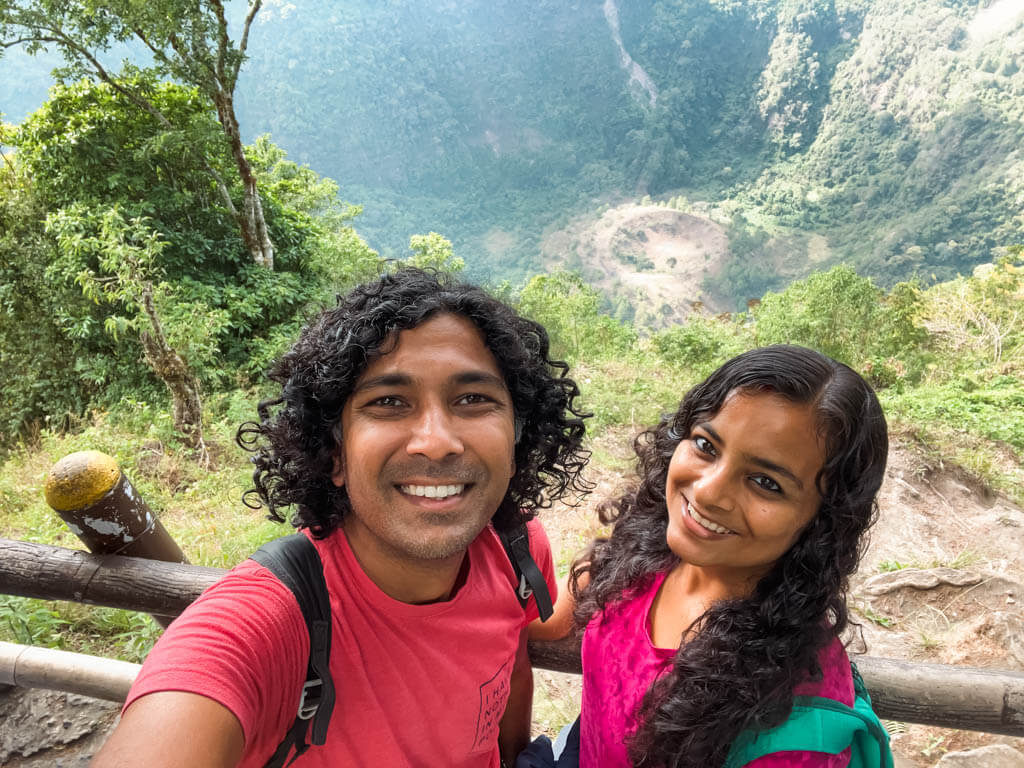
Day 3: San Salvador > Suchitoto
Today is a travel day, but an easy one. The next destination on your El Salvador itinerary is Suchitoto, a charming town known for its colonial architecture, cobblestone streets, cultural heritage and vibrant character. To go with the mood of the destination, set the itinerary pace to relaxed for the next couple of days.
Morning: Check out from San Salvador
So, on Day 3, finish your breakfast, pack your things and take your time to check out of your hotel in San Salvador. Suchitoto lies only 50 km (31 miles) to the east of San Salvador, and the drive does not take more than couple of hours.
However, account for longer if you are going to take the public bus. For this option, you need to catch the bus 129 from the new terminal on the east, marked on Google Maps as Terminal Plaza Amanecer.
Afternoon: Introduction to Suchitoto
Once you reach Suchitoto and settle in at your hotel, grab lunch at one of the nice restaurants and set out for an afternoon stroll.
Immerse yourself in the serenity of the afternoon as you walk down the cobblestone street and pass by colorful houses, and head to the Alejandro Cotto Museum. It is the home of the famous Salvadoran filmmaker Alejandro Cotto, known for his remarkable contribution and pioneering journey in the world El Salvador cinema and art. This house has now been turned into a museum where you can find his works of art as well as his personal belongings and furnitures, a museum similar to the concept of Frida Kahlo’s house in Mexico City.
After the museum visit, make a pitstop at the Casa 1800 Suchitoto Boutique Hotel. Lounge with a cup of coffee and admire spectacular views of the Lake Suchitlan. It is a pricey place but some may argue that it is worth the experience.
We have to warn you though that you may feel like staying at Casa 1800 for much longer that a coffee break. A simple solution to that desire is to book the hotel in advance as your accommodation choice in Suchitoto.
Check availability and prices at Casa 1800 Suchitoto.
Evening: Town Center at Night
Once back at the town center, watch the daylight making way for the darkness of the evening. Grab a seat at a pupuseria by the plaza and watch life go by while gorging on delicious pupusas. watch the white church wear different colors and the plaza come alive with people gatherings and food vendors.
Return to the central park the next morning and see the same spot in new light.
Click here to search for the best hotels in Suchitoto
Day 4: Suchitoto – Town + Waterfall
Dedicate Day 4 to a full day exploration of Suchitoto.
Morning: Town Center, Church, Markets, Museums
Pick up from where you left the night before, and see the center of town, the Parque Central bustling in broad daylight. Start your Suchitoto sightseeing from here. These are the spots that you can add to your self-guided walking route for the morning.
- Santa Lucia Church: The main church of Suchitoto with soothing white exterior and pleasant architecture.
- Parque Central: The bustling town center with cobblestone streets, church, market and eateries on its periphery.
- Arte Añil: A cultural center and store where you can attend workshops to learn about traditional indigo dyeing and also shop for art and apparels dyed in indigo.
- Museo de la Moneda: Museum with a collection of coins and bills, currencies collected from across continents.
- Parque San Martin: A nice park with well-maintained landscaping and shades seats ideal for a little rest on a sunny day.
- Centro Arte Para La Paz: A cultural center that promotes peace through creativity and imagination through various forms of arts and performances.
All of the places mentioned above are within walking distance of each other within half a mile radius. So, depending on your interests, you may switch the order of the spots. Yet you should be able to visit all of these in half a day.
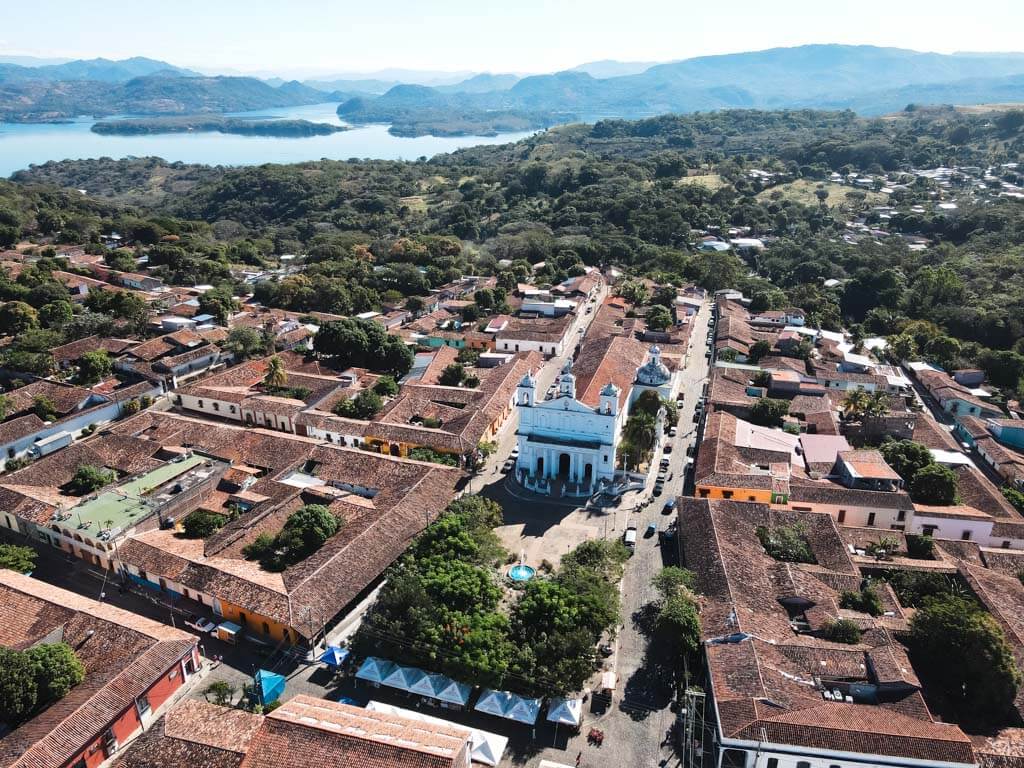
Afternoon: Los Tercios Waterfall
After all the walking in the sun, treat yourself to a hearty meal at a restaurant.
Once you have refilled your fuel levels, set out for a longer walk, but this time to spend time in nature. This afternoon, you are going to visit the waterfall Los Tercios.
To get to the waterfall, you will need to complete a short but steep downhill hike on rough rocks, often needing to concentrate on how to balance yourself. But once you get there, actually from even before, the views are going to be rewarding.
Los Tercios waterfall looks like no other because of its unique and interesting formation. The water slides down piles of big hexagonal stones placed in layers. Reminded us of the infamous throne of the Game of Thrones!
However, this waterfall is highly seasonal and has flow of water only during the rainy season. We visited Los Tercios in the month of January when there was no trace of water at the waterfall.
We still enjoyed this waterfall visit as the landscape is truly impressive. Also, at this waterfall location, you can walk to a Mirador from where you get expansive views of the Lake Suchitlan.
Related Reading: Things to Do in Suchitoto + City Guide
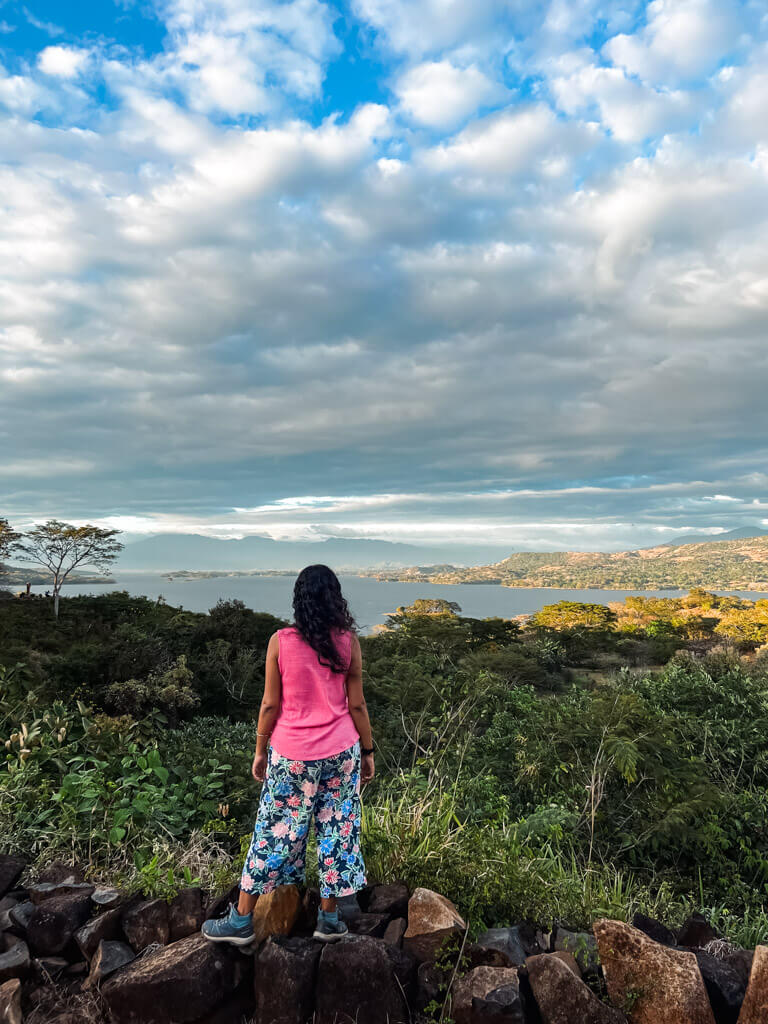
Day 5: Suchitoto > Santa Ana
After a relaxing couple of nights in an old town, now it is time to move to your next destination and look forward to some nature and outdoor activities in the coming days. Next stop on your El Salvador itinerary: Santa Ana.
Morning: Transfer to Santa Ana
Santa Ana is a couple of hours drive away from Suchitoto. So, a comfortable morning start should get you to Santa Ana by midday and leave plenty of time to explore the town in the afternoon.
If you are not renting a car, the public bus route here is a little more complex than a direct transfer, but still it is doable. You will need to change buses a couple of times. Now, there are two ways to go about it, one via San Salvador, and the other one bypassing the traffic of San Salvador city traffic.
Public Transport via San Salvador
- Take bus #129 from Suchitoto to San Salvador. It arrives at the new Terminal de Oriente (Terminal Plaza Amanecer).
- Transfer within city from this terminal to the terminal on the west, Terminal de Buses de Occidente by a public bus or Uber.
- From this terminal, take the TUDO bus #201 from San Salvador to Santa Ana.
Public Transport bypassing San Salvador
We have personally not traveled on this route. But research tells us that this is a viable transfer option which helps you to skip the city traffic of San Salvador.
- Suchitoto to Aguilares by bus #163
- Aguilares to Apopa by bu #119 or #125
- Apopa to Santa Ana by #276
Note that, on this route, you will be embarking and disembarking between the end stops. So, for each ride, it would be wise to have a chat with the driver about where you should be dropped off to catch the next bus.
In our personal experience of bus rides in El Salvador, the drivers and/or the helpers are helpful and pay attention to remind you of your next stop. The fellow co-passengers are also usually very friendly and proactively guide you for your journey.
Afternoon: Santa Ana Town
After you are done with the check-in formalities at your hotel in Santa Ana, take the afternoon to get to know the pulse of the city.
Walk the quiet streets and pass by colorful neighborhoods, and head to the main square in town, Parque Libertad, which is always bustling with people and activities. You can pick up a snack from one of the several food vendors surrounding the central park.
The two iconic spots around this square are the Santa Ana cathedral and the National Theater of Santa Ana.
The cathedral was originally built in the 16th century and went through damages and reconstructions over the centuries. It is now a national monument of El Salvador, a beautiful white architecture standing tall as the icon of Santa Ana’s history and cultural heritage.
The theater also attracts visitors with its impressive architecture. You can book a guided tour of the theater or catch a live show to get glimpses of the interior too.
To know more about this important city of El Salvador, read our Santa Ana city guide and watch our Santa Ana YouTube video.
And while you are out and about exploring the town of Santa Ana, indulge in a few pupusas for an early dinner.
Click here to search for the best hotels in Santa Ana
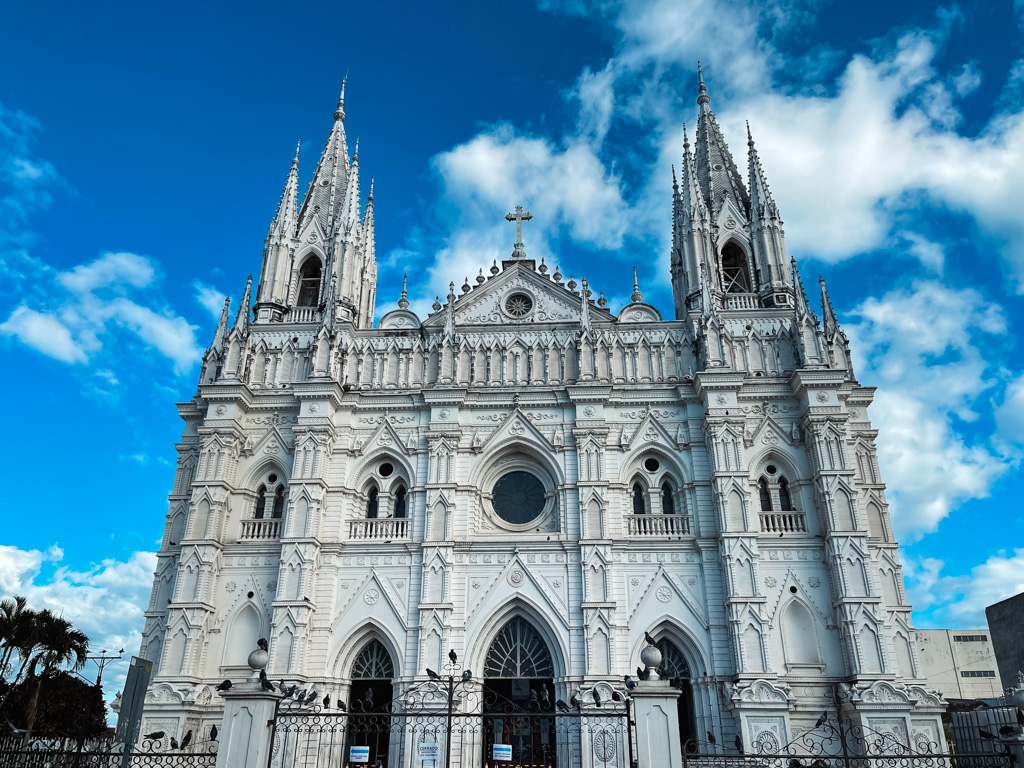
Day 6: Santa Ana – Mayan Ruins + Hot Spring Waterfalls
Day 6 on your El Savador itinerary is a fantastic combination of history and nature.
Morning: El Tazumal and Casa Blanca
In the morning, visit El Tazumal Archaeological Park, located in the town of Chalchuapa, about 14 km (8.6 miles) from Santa Ana.
This archaeological site is home to the Mayan ruins dating back a few centuries. Here you can see the main pyramid and other structures, like temples, columns, oratory and ball courts. The site is open from 9:00 am to 4:00 pm everyday except Mondays and the entry costs 5 USD per person for foreigner adults.
To know more about this historic site and plan your visit, read our Tazumal visit guide and watch our El Tazumal video on YouTube.
To complement the visit to Tazumal ruins, make your next stop the Casa Blanca Archaeological Park. It is only about a mile from El Tazumal. At Casa Blanca, you get to see mounds and structures which once made up a ceremonial site in the pre-Hispanic times. Also, visit the museum where you get to learn more about the Mayan history and appreciate the interesting architecture and layout of the museum itself.
Finish up your morning in Chalchuapa with a nice lunch or pick up a packed lunch. Then prepare for a wild and wonderful afternoon.
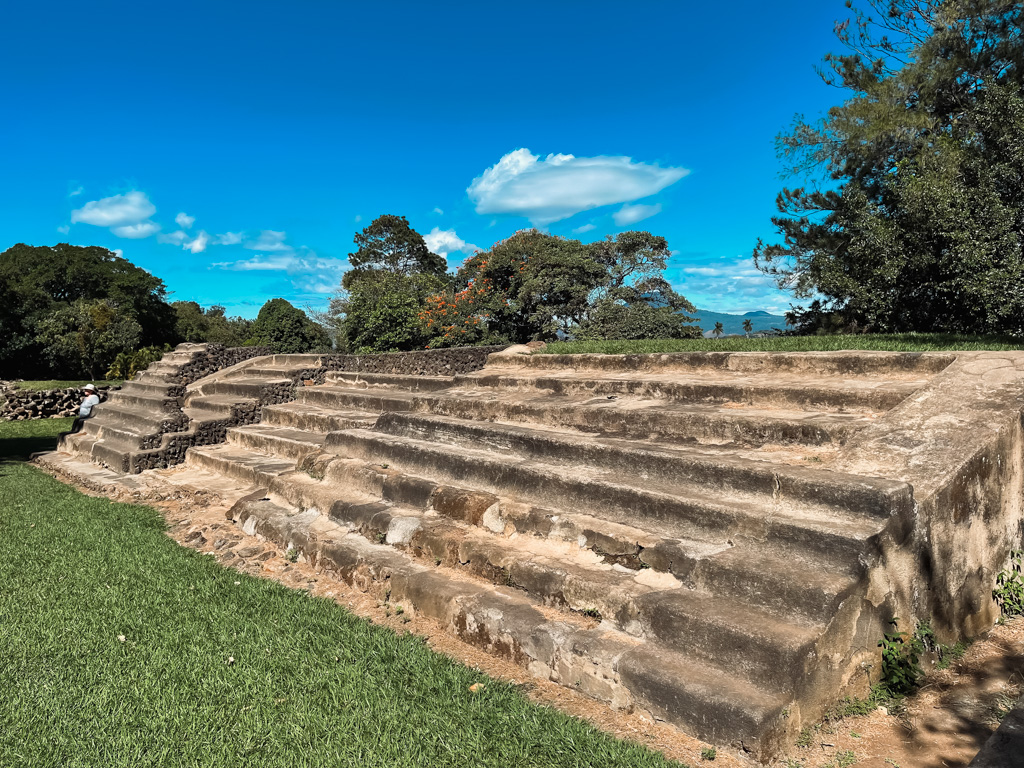
Afternoon: El Salto de Malacatiupan
Next stop is El Salto de Malacatiupan. This beautiful place, kind of in the middle of nowhere, is among our top favorites of all the places we visited in El Salvador. It is a place of hot spring waterfalls! Yes, hot springs AND waterfalls. What a delightful mix that is for people with affinity towards water 🙂
There are multiple waterfalls. You can go close to the falls and feel the cold stream of water running over your body. Immediately after, you can get into the natural pools, where you soak in the warm water of the hot spring. If you feel adventurous, you can also jump off the edge of a cliff into the bigger hot spring pool.
To plan your visit, read our complete guide to El Salto de Malacatiupan, and to get a feel of what to expect, watch our YouTube video of the hot spring waterfalls.
Enjoy sitting in the shade of the trees, jump from the edge in to the big pool, swim a bit, come up latching on to a rope, walk back and get back under the cold stream of waterfalls, relax in the smaller hot spring water natural pools. Oh we could do this cycle on repeat for the whole day!
But that is when we are reminded of Robert Frost’s famous lines:
"The woods are lovely, dark and deep, But I have promises to keep, And miles to go before I sleep, And miles to go before I sleep."
After a fun-filled afternoon, head back to Santa Ana, take it easy in the evening, rest well at night and prepare for an exciting next day.
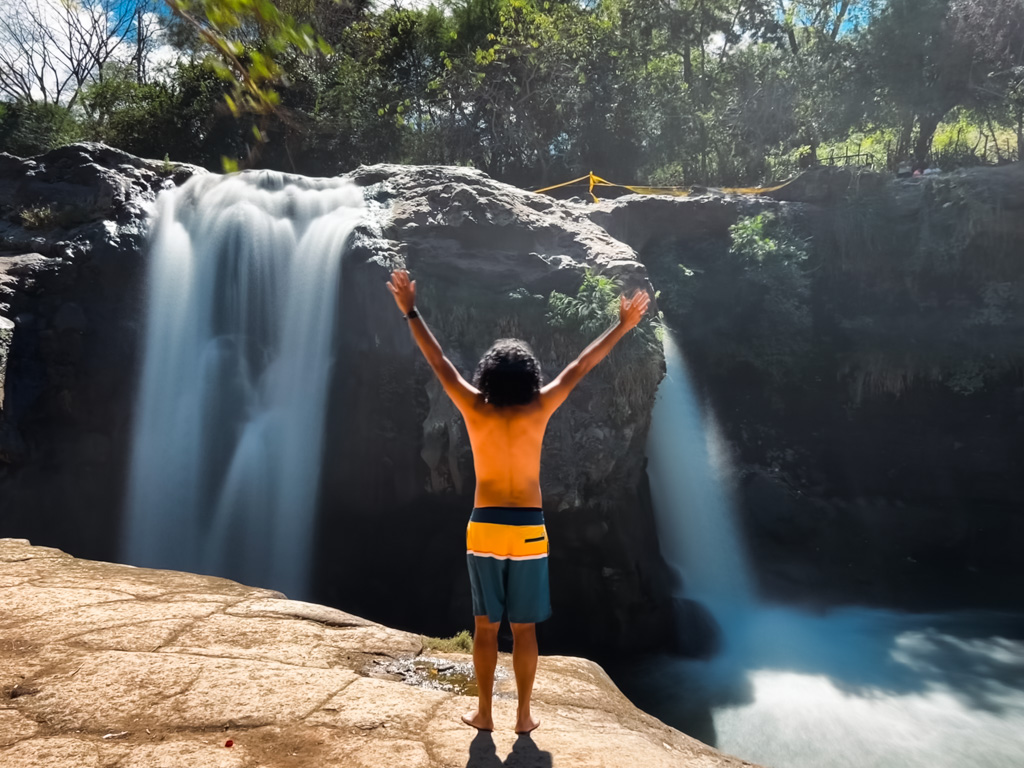
Day 7: Santa Ana – Ilamatepec Volcano Hike + Coatepeque Lake
Start the day early, have a filling breakfast, and get ready for an adventure that can turn out to be the highlight of your El Salvador trip.
Morning: Santa Ana Volcano Hike
On Day 7, you are going to hike up to the top of the Ilamatepec Volcano, the highest volcano in El Salvador. This volcano, also known as the Santa Ana volcano, is 2381 meters (7812 feet) high and is active with last recorded eruption in the year 2005.
This volcano hike, as thrilling as it may sound, is NOT an extremely difficult hike. In fact, compared to the Acatenango Volcano Hike in Guatemala, one may find this one easy.
Of course you will need to walk uphill and downhill, on rocks and winding paths, at times in the shades of Cerro Verde National Park, but most of the times directly under the sun. Still, it is an enjoyable hike for anyone with a good fitness level and without any obstructing health condition. Just make sure you prepare well and know what to expect from the Santa Ana volcano hike.
At the summit of the Santa Ana volcano, you will be rewarded with the views of an emerald color crater lake, the neighboring Izalco volcano, the striking blue Coatepeque Lake and lush mountains and valley. Not just at the summit, you will get arresting scenery views on the way up and down as well. So, during the hike, take your time to pause and admire the beauty around you.
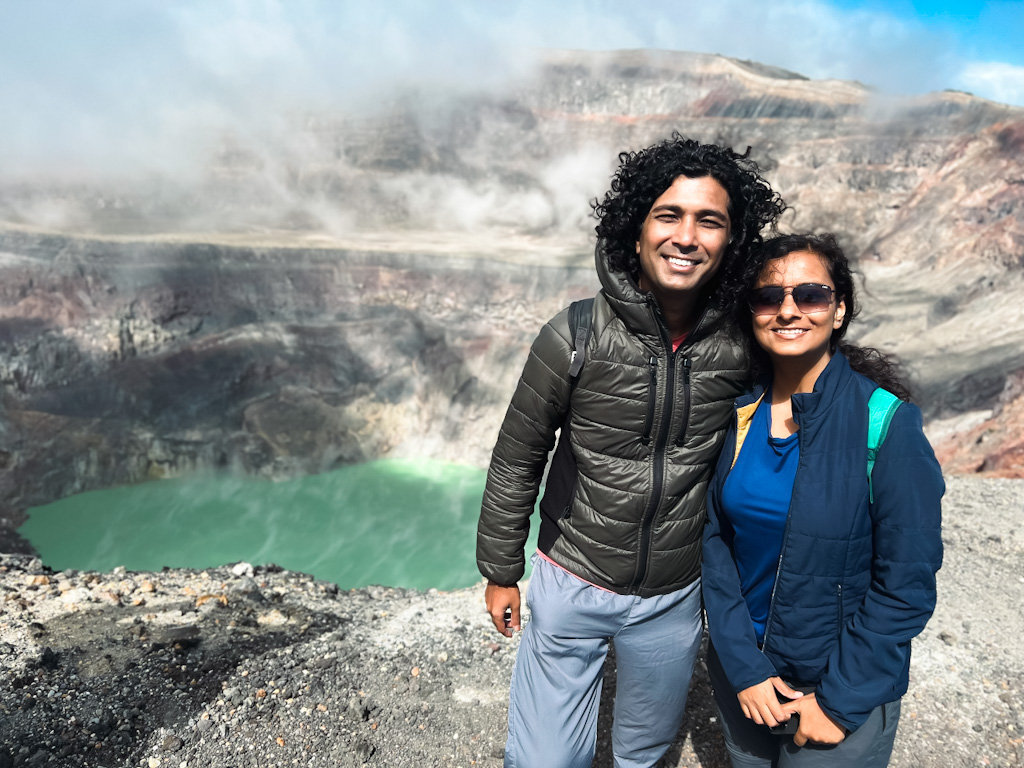
Afternoon: Coatepeque Lake
After the Santa Ana volcano hike, a common next stop is the Coatepeque Lake. It is a big volcanic lake with magnificent blue color water.
Most hikers take some time after the volcano hike to visit Coatepeque or have lunch at one of the restaurants with panoramic views of the lake. That is what we did. But we have planned one better for you 🙂
Head to Coatepeque not just for a visit, but to actually stay there. So it is not just the impressive sight of the lake, there are plenty of things to do too in and around the Coatepeque Lake.
Tip: Since you are going to stay at Coatepeque, in the morning, check out with all your things when leaving Santa Ana town in the morning. You can arrange to store your luggage at the front gate before starting the Santa Ana volcano hike, or leave it with your Santa Ana hotel luggage storage for couple of nights.
To conclude the day of your Santa Ana volcano, check in to your hotel in Coatepeque, munch on a meal and sip on a drink while you sit back and enjoy the views of the lake.
Because of its location and all the amenities and socializing opportunities it offers, Captain Morgan Hostel is a popular choice for affordable stay in Coatepeque, as well as for day visits. For accommodation choices, the hostel offers private rooms, dormitories and even hammocks.
Day 8: Coatepeque Lake
Spend the whole day by Coatepeque Lake, whether you want to relax or dive in straight to the activities.
Before we get into the details of the activities at the lake, let’s talk a bit about the accommodation.
You are spending two nights at Coatepeque Lake where the lake itself is the primary attraction. So it is important that you choose your accommodation carefully.
We say, pick something that lets you stay close to the lake, offers lake views, and helps you plan and participate in activities. Check this hostel for fun vibes, and this place for apartment style accommodation with lake views.
Now for the activities, there are several things to do at Coatepeque Lake. Some of the common options are swimming, fishing, boating, kayaking and jet skiing. But if you are willing to sign up for something adventurous, go scuba diving in Coatepeque Lake.
The unique aspect of Coatepeque Lake scuba diving is that you will be diving in a volcanic caldera located between the Ilamatepec Volcano and the Izalco Volcano. As you dive into this crater lake, you may get to see some last remaining secondary volcanic activities as well as species of fish.
However, note that, Coatepeque Lake is not a common dive destination in El Salvador, so these are not always on a regular schedule. Check with PADI certified dive schools if they offer dives here. La Libertad Diving is one such dive school.
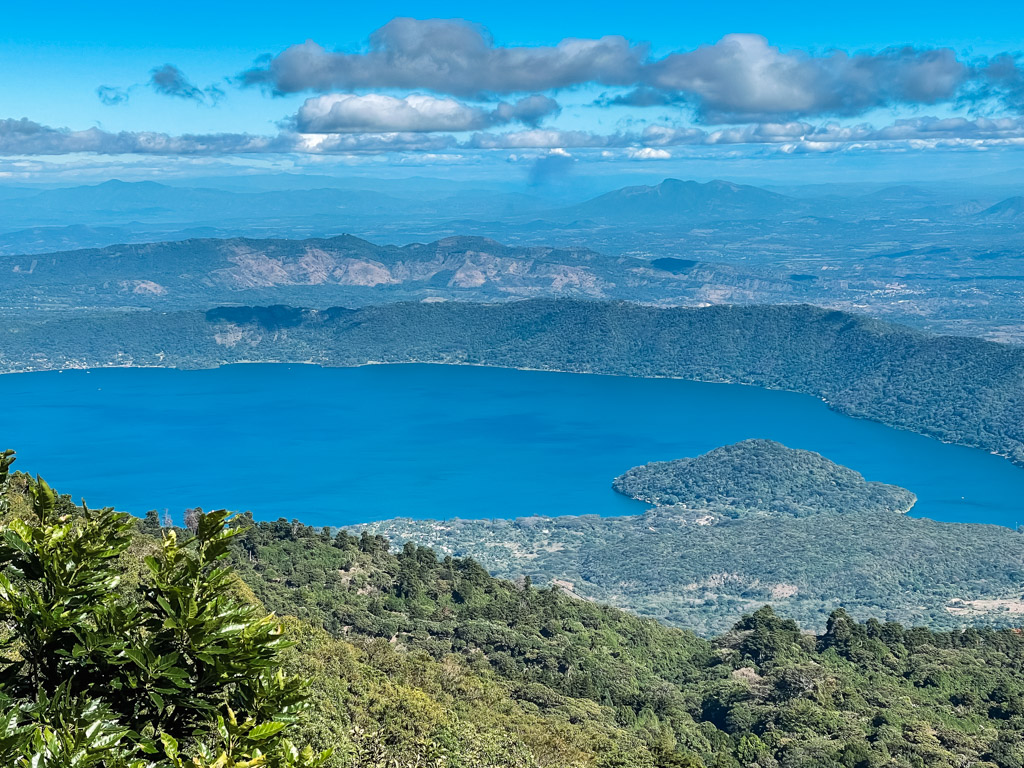
(Day 1 – Day 8) Alternative Itinerary
For Day 1 through Day 7, instead of moving around a lot, you can base yourself in San Salvador and take multiple day trips to explore most of the places listed above. If you choose to take this route, you can book these tours. All of them start from San Salvador, and include ground transportation and the services of a certified guide.
- San Salvador City Tour + El Boqueron National Park
- Santa Ana Volcano Hike + Coatepeque Lake
- Mayan Ruins (3 Sites) + Santa Ana Town Center
- Suchitoto Day Trip
The next two destinations on this El Salvador itinerary, Ruta de las Flores and Surf City, can also be done as day trips from San Salvador. But we strongly suggest to spend at least 2-3 nights in each of those destinations. Else you will only see the highlights there.
So, read on for your El Salvador itinerary plan from Day 9 onwards.
Day 9: Coatepeque Lake > Ruta de las Flores
After exploring cities and towns, history and culture, volcanoes and lakes of El Salvador, now it is time to head to the mountains. Next destination on your El Salvador itinerary: Ruta de las Flores.
Ruta de las Flores, Spanish for The Flower Route, is a scenic route between the towns of Ahuachapán and Sonsonate. Tucked between these two towns are five other smaller towns – Nahuizalco, Salcoatitán, Juayúa, Apaneca, and Concepción de Ataco.
The Flower Route gets its name from the wildflowers that bloom along the sides of the road between the months of November and February. So if you want higher chances of seeing these wildflowers, plan your trip within this window. But even if your planned trip does not fall in that period, include Ruta de las Flores as a must visit on your El Salvador itinerary.
Quaint mountain towns, colonial architectures, coffee plantations, adventure parks, waterfall hikes, colorful art, local markets and food festivals – there is plenty to see and do along the Ruta de las Fores.
You can base yourself in one of the towns and explore the top attractions of the nearby towns too. Juayua is the most popular among tourists. We had stayed in Concepción de Ataco as our base, and absolutely adored the vibes of that charming mountain town.
Whichever town you choose to stay at, go out for a walk and visit the town center in the evening. The main square of the town is usually a nice spot from where you can see all the happenings around.
Click here to search for the best hotels in Juayua
Click here to search for the best hotels in Concepcion de Ataco
How to get to Ruta de las Flores from Coatepeque Lake
Depending on which town you choose to base yourself along the Ruta de las Flores, there are couple of options for the transfer between destinations.
- Option 1: By driving your rental car in El Salvador.
- Option 2: Take the public transport:
- Coatepeque Lake to Santa Ana by bus #242
- Santa Ana to Juayua by bus #238
- Juayua to Concepción de Ataco by bus #249
Day 10: Ruta de las Flores – Juayua
Start your first full day in Ruta de las Flores by exploring its most popular town, Juayua. Let us plan this day as a mix of nature, culture and food.
Morning: Seven Waterfalls Hike
As the name suggests, the Seven Waterfalls Hike in Juayua takes you to seven different waterfalls. But this is not merely a walk in the jungle.
You will be hiking on, occasionally uphill, dirt paths and jungle trails, wading in knee deep river water and scrambling on big rocks. On this 6-hour long adrenaline rushed tour, a time will come when you will doubt the feasibility of this activity. This is where you will have to rappel up a waterfall, behind the curtain of the waterfall and climb up the huge wall of rock, in order to get to the next set of waterfalls.
You can possibly imagine by now that the Seven Waterfalls Hike (Siete Cascadas, in Spanish) can be carried out only under the supervision of a skilled guide. Before you sign up for the tour, ask your guide or tour provider about the arrangements for the rappelling equipment. This is very important for your safety during the hike.
During our Seven waterfalls Hike, for some reason (year end holiday, probably), the rappelling equipment team was not present on site. So our guide asked us to just climb the huge wall of rock behind the curtain of the waterfall, using our four limbs only. Not a single other support equipment! What did we do? Watch this video to find out.
We did the tour with Christian from Pulunte House in Majada. He is a nice and friendly guy who spoke about the history and geography of the place. You can contact Christian by WhatsApp +503 7729 9173 or on Instagram @puluntehouse
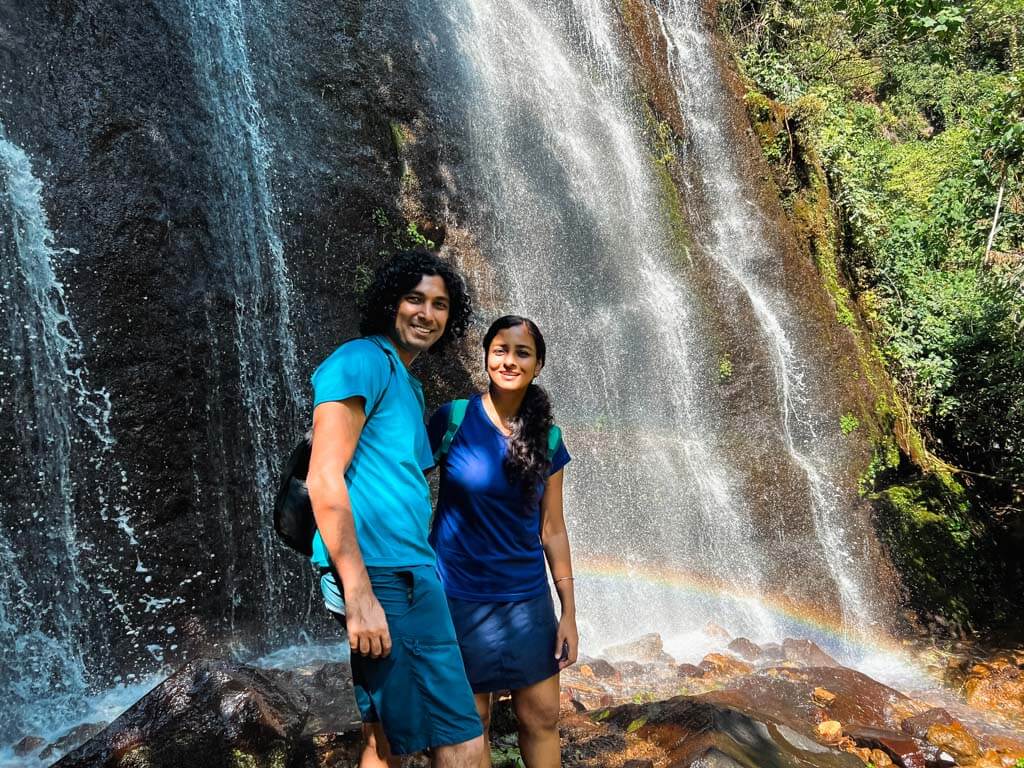
Afternoon: Juayua Town
After the Siete Cascadas hike, take the afternoon to explore the town of Juayua. Walk along the streets, observe local markets, shop souvenirs from the craft stores. Hang out around the town center and visit the Cristo Negro Church. It has white and red exterior walls and houses inside the statue of Black Christ.
If you can make your Juayua travel plan for a weekend, do not miss the Juayua Food Festival. A weekly affair, when various food vendors set up stalls on the streets and allure visitors with delectable food and inviting beverages.
During early January every year, the church celebrates the Festival of Cristo Negro. While the festival holds religious significance for practicing Catholics, for visitors, it can be an opportunity to see an otherwise tranquil town in different moods and colors. This is when people of Juayua come together to celebrate the festival with costumes and parades, food and drinks, flaming bulls and fireworks.
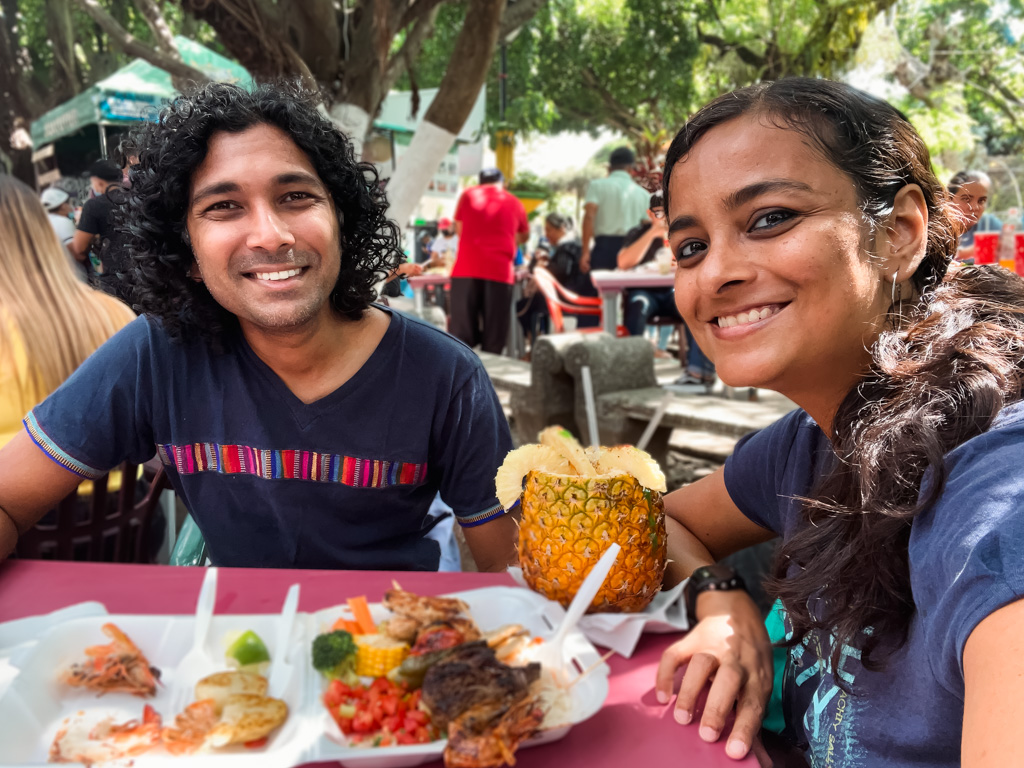
Day 11: Ruta de las Flores – Concepción de Ataco + Apaneca
On Day 11 of your El Savador itinerary, visit another couple of towns along the Ruta de las Flores, Concepción de Ataco and Apaneca. Although Juayua is the most popular, these two were our favorites out of all the towns of Ruta de las Flores.
Morning: Apaneca
Start with visiting the center of Apaneca town. Walk the pretty streets, visit the local markets and see the cute wall murals. Grab a cup of coffee and smell the crisp mountain air for a peaceful start to the morning.
Then jump in (literally and figuratively) for adventures. Head to the Insta famous adventure park Cafe Albania.
The most popular attraction at this park is their labyrinth. Here you walk in to a maze, get to the center of the maze and climb a staircase to get to a platform and ring a big bell, and then work your way out of the maze. It may sound like an interesting kids thing to do. But we as full-grown adults, as well as many other fellow adult visitors, had fun working this challenge. Once you get to the platform top to ring the big bell, the views are also pretty nice.
At Cafe Albania, they offer several other activities, some of which can be adrenaline pumping. Apart from a regular canopy tour and a colorful rainbow slide, you can also go for activities such as pendulum swing, air surfing and bike zip-lining.
The entry to Cafe Albania costs 5 USD per person and includes access to the labyrinth and the restaurant and cafe. However for other activities, you have to purchase tickets separately for each one. You can check the latest pricing and schedule on their website (it is in Spanish).
You can also grab a bite and a drink at the restaurant here with nice views of the scenery as well as the adventure activities.
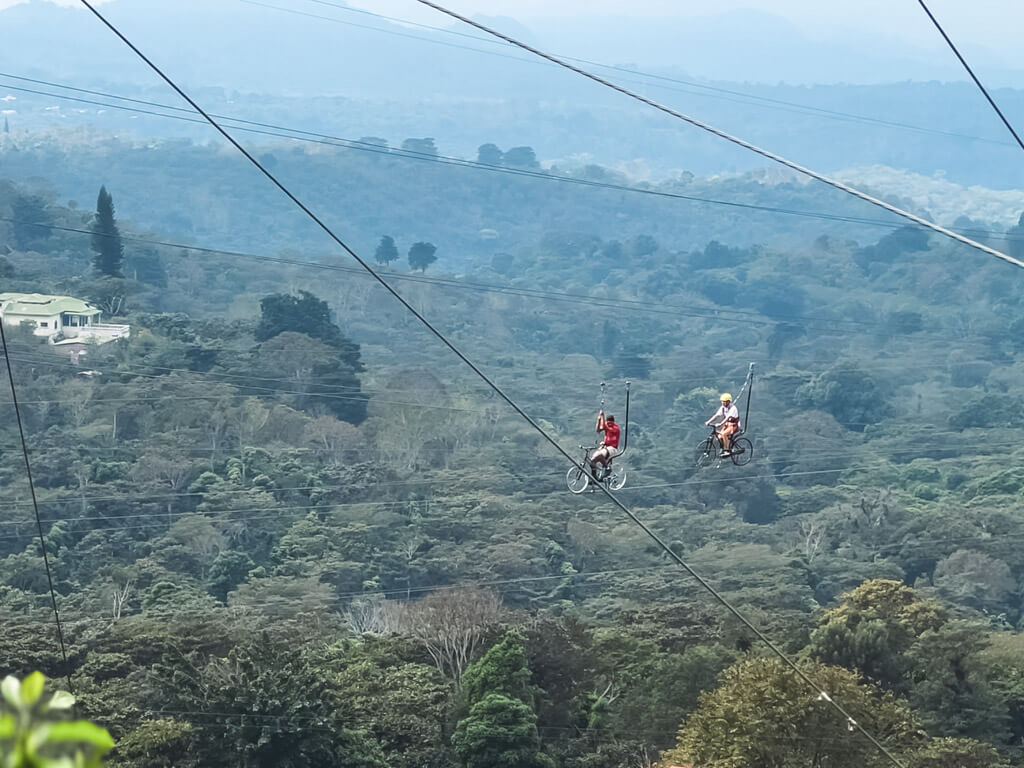
Afternoon: Concepción de Ataco
For the second half, get yourself to Concepción de Ataco. It is a picturesque mountain town adorned with cobblestone streets, colorful markets, attractive wall murals, and surrounded by beautiful mountain landscapes.
For an afternoon in Ataco, walk around, get a feel of the place, visit the church, hike up to the Cerro de la Cruz viewpoint. Eat from the street vendors and shop at the art and craft stores.
Ataco takes pride in its coffee culture. There are a few farms around where you can sign up for a coffee tour experience. El Carmen Estate is one such option, where you get to choose from two different tours, a basic one, called “Traditional Tour”, and another full-service full-experience tour, called “Integral Tour”.
Another interesting thing to do when in Ataco is to visit a hot springs center nearby. We went to the Alicante Hot Springs in Ahuachapan. Another nearby hot spring property in Ruta de las Flores is the Santa Teresa Hot Springs.
Honestly, although the Alicante Hot Springs property is nice, it felt underwhelming compared to the hot springs in La Fortuna, Costa Rica, where you get more of a dreamy experience.
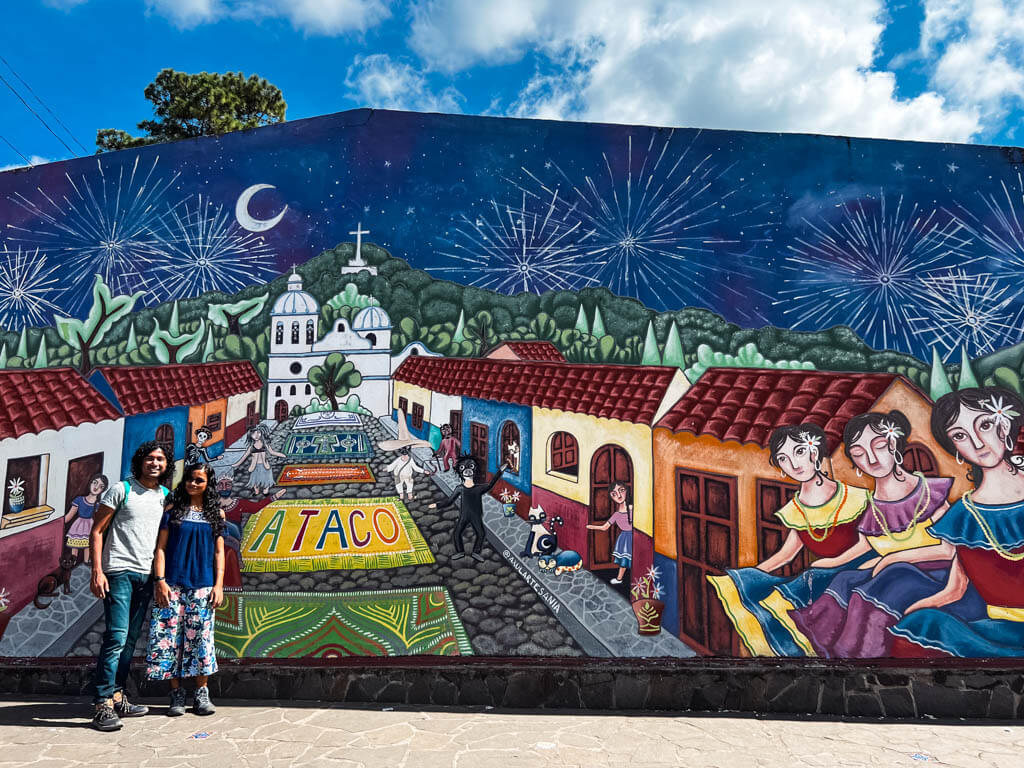
Day 12: Ruta de Las Flores > Surf City
It is now time to head to the last destination on your El Salvador itinerary. We have saved the beach R&R for the end.
So, on Day 12, pack your bags, bid your bye to Ruta de las Flores and head to the Pacific coast of El Salvador.
The country is known for some of the best surfing spots in Latin America. And the El Salvador tourism board has done a fantastic job of packaging its best surfing beaches under the umbrella name of Surf City. The waves are endless, the sun is shining, and the surf culture is thriving in this part of El Salvador.
There are multiple beaches to choose from for your stay in Surf City. If you are a surfer and looking for the most popular surfing spots in El Salvador, look no further than El Tunco beach. It is a small but busy beach where you will find plenty of resorts and hotels, restaurants and bars. Souvenir stores and surf shops line the streets. As you can imagine, the nightlife in El Tunco is quite busy.
If you are looking for a quieter place to stay, our pick is El Zonte. You will still find many beautiful places to stay in El Zonte, as well as good waves to surf. And if you feel like being in the middle of action one fine evening, you are only a 15-minute drive away from El Tunco.
You should be able to get to your beach destination just in time to catch a spectacular sunset. And then, if you are up for it, go out and check out the night scene of El Tunco.
How to Reach Surf City from Ruta de las Fores
From Juayua or Ataco in Ruta de las Flores, driving a car can take around 2-2.5 hours to reach El Tunco or El Zonte.
If you avail the public bus, you need to break the journey in to couple of legs and the journey time is much longer. There are couple of ways to do this. We recommend the first option as the frequency of microbus 102A is much higher that bus #287.
- Option 1: Travel to San Salvador. Then take the microbus 102A which passes by El Tunco and El Zonte.
- Option 2: Travel to Sonsonate. Then take bus #287 to the beach towns.
Did you know El Zonte is also referred to as the Bitcoin Beach. This is where it all started – El Salvador’s revolutionary decision to make Bitcoin a legal tender in their country,
Click here to search for the best hotels in El Zonte
Click here to search for the best hotels in El Sunzal
Day 13: Surf City – Tamanique Waterfalls + Beach Time
Are you up for yet another hike? I know Surf City was supposed to be for beach R&R. But this activity is worth having on your itinerary if you like chasing waterfalls and also get some workout done in the process. Sounds convincing?
Morning: Tamanique Waterfalls Hike
In the morning hike the Tamanique Waterfalls, a series of some magnificent waterfalls and cascades.
This invigorating hike takes you through jungle trails with lush vegetation and vibrant flora. Along the route, you come across open lookouts to picturesque landscapes. When you reach closer to the first waterfall, the soothing sound of cascading water starts to accompany you.
There are waterfalls of varying heights and volumes to see. Standing close to the waterfalls, you can feel the cool mist on your face. To beat the heat, take a dip in the crystal-clear natural pools and get refreshed instantly. If you are feeling adventurous, you can even jump off the edge into a pool, or slide down a waterfall. If you fancy waterfalls with natural slides, check the Catarata Uvita in Costa Rica.
For Tamanique waterfalls hike, start early because it gets more hot and humid as the day progresses. Wear your hiking shoes for the trail and carry your water shoes for swimming in the natural pools.
Read our Tamanique Waterfalls Hike guide and watch our YouTube video for more details on what to expect from this hike.
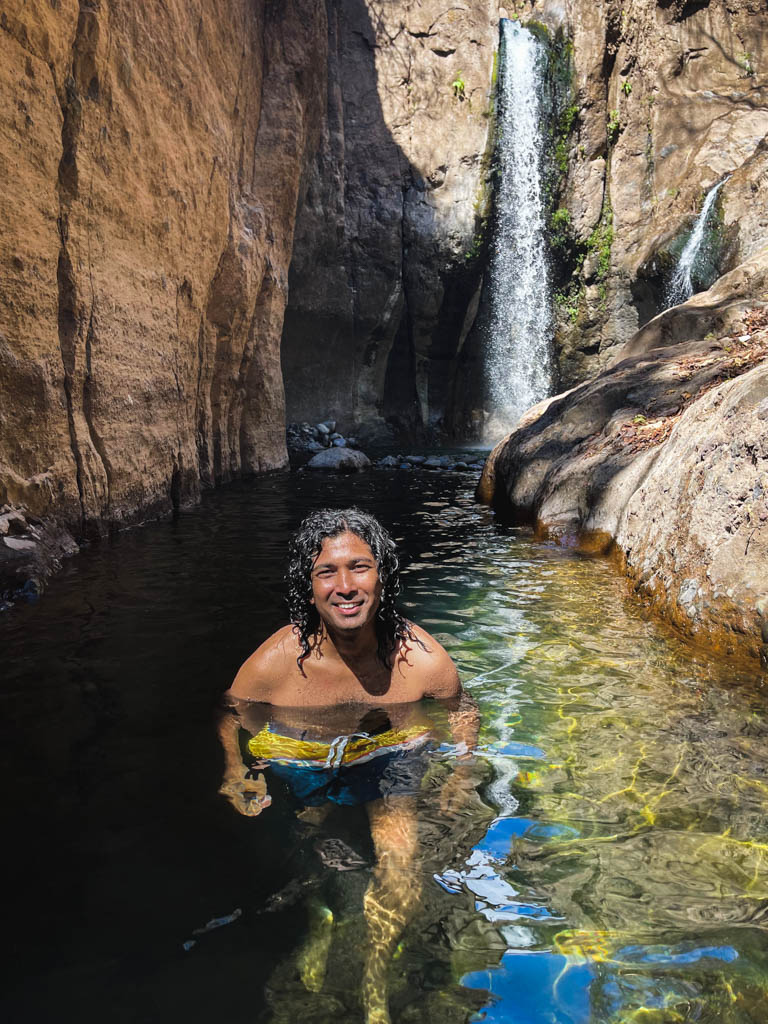
Afternoon: Beach R&R, Surfing and Sunset
Let’s finally get you that beach time for your penultimate day in El Salvador.
Grab a seat at a nice ocean view restaurant and indulge in a good meal. Gaze at the rhythm of the waves while you sip on a cool drink.
However, like us, if you prefer to have more activities on your itinerary than relaxation time, take your surfboard out to ride some of the best waves. If you are new to surfing or a beginner, may be sign up for a lesson with a surf school or a private instructor. After all, you are in a surf mecca that beckons travelers from around the world. You may want to know why.
Whichever way you choose to spend your afternoon, do not miss a beach sunset to start your last evening in El Salvador. And we will tell you exactly where to catch an gorgeous one with intesresting perspectives.
If you go to the west end of El Zonte beach, you will find some cave formations. You can walk past them, or for some thrill, through them. Climb the stair to get up to a vantage point on the side of the cave. Grab a spot to sit and enjoy a spectacular sunset. Check this YouTube short to get a glimpse of what we are talking about.
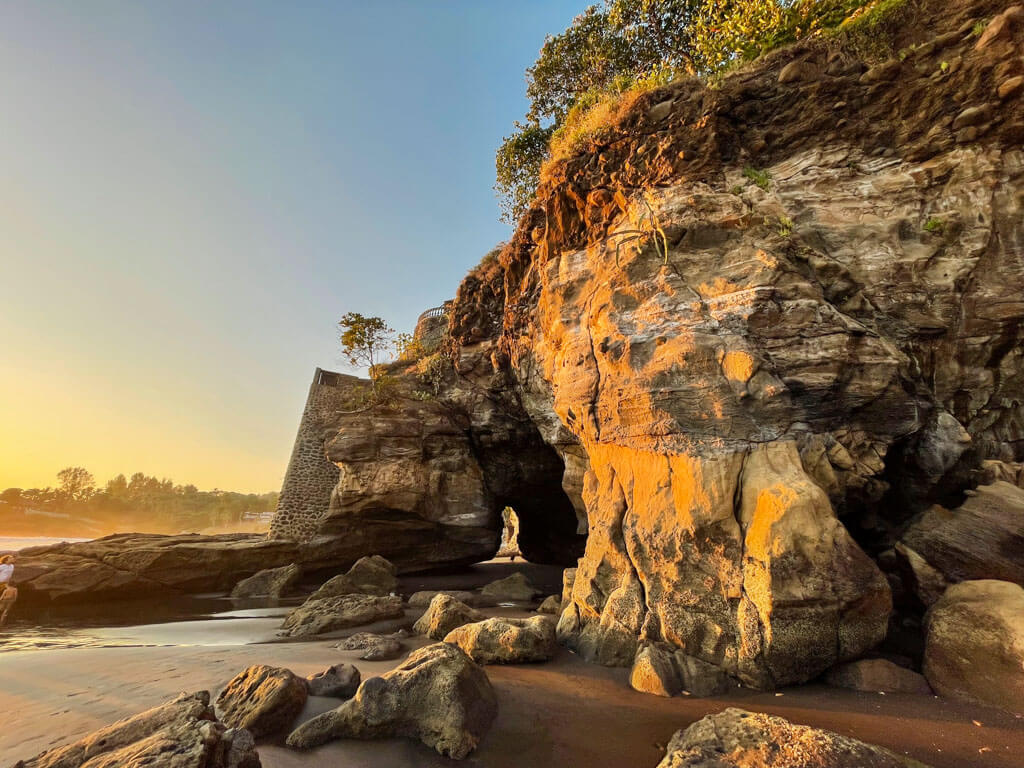
Day 14: Surf City > Airport: Fly Out
Last morning in El Salvador, enjoy it as you like it the best. Go for a morning walk on the beach. Have breakfast by the beach. Just sit on the sand and watch the ocean waves crash on to the shore. Or may be, sneak in one last surf session?
After checking out from the hotel, you can go straight to the airport to catch your flight out of the country. It takes about 70-90 minutes to commute from El Tunco or El Zonte to El Salvador international airport. Remember this where you can also return your rental car.
Best Time to Visit El Salvador
El Salvador has a tropical climate with two distinct seasons, rainy season and dry season.
The best time to visit El Salvador is during the dry season, between the months of November and April. You can expect clear weather and sunny days. But to escape the peak season price rises, you may want to avoid traveling during Christmas, New Year and Easter.
Rainy season runs from May through October when the greenery is at its lushest. However, hiking trails may become slippery thus limiting the possibilities of outdoor activities. The prices of hotels and tours drop during this period as it is the low season.
We traveled in El Salvador in December and January, and got excellent weather thought our 1 month stay. Yes, we did spend Christmas and New Year there, but not at the beach, where it’s the priciest.
What to Pack for your El Salvador Itinerary?
Some of the essentials you need to pack for El Salvador are:
- Light and comfortable clothing for tropical climate
- Light jacket for the top of Santa Ana volcano
- Swimwear for waterfalls, beaches and hot springs
- Hiking shoes for volcano and waterfalls hike, comfortable walking shoes for the cities, and flip-flops for the beach
- Insect repellant. We like this insect repellent as it is a spray and not a cream or lotion, and hence easy to apply.
- Sunscreen. Use a reef safe sunscreen like this when swimming in the ocean.
Your packing list will remain more or less the same for traveling to all countries in Central America. For reference, check our Costa Rica packing guide for a detailed list. It also comes with a FREE checklist!
Final Thoughts on El Salvador Itinerary
From our years of travels in Latin Ameria, El Salvador is one destination that took us the most by surprise.
Before arriving, we knew that there were waves to surf, volcanoes to hike, Mayan ruins to see, and pupusas to taste. We did all of that and they did quench our travel thirsty souls. But at the time of leaving the country, what filled our hearts the most was the incredible hospitality of the people of El Salvador.
We say, give this country a chance. Do not skip El Salvador. Be open to embrace experiences and take back wonderful memories.
But start with planning the trip well, because this country is still in its nascent stage of tourism development journey. So prior planning and preparation can help you make the most of your trip. Hope this El Salvador itinerary can be a good starting point for that.
For more travel planning resources, check our El Salvador content library.
Travel Planning Logistics
- Accommodation: For several years now, Booking.com has been our platform of choice for booking accommodation while traveling. You can apply all the desired filters and shortlist the ones that meet your criteria. On continued use, you will keep unlocking their Genius benefits. For long term stays, we use Airbnb. Of late, we have also started browsing Hostelworld for finding hostels.
- Tours: When traveling to new destinations, you can plan ahead and book your activities. Check for highly rated tours on Viator and Get Your Guide.
- Packing: From swimwear to sunscreen, hiking pants to insect repellents, buy your vacation packing essentials on Amazon.
- Flights: We always start our flight searches with Skyscanner and Momondo. They are aggregators that display flight options, compiling information across airlines and combinations. What we like the best about these flight aggregators is that you can put “Anywhere” as your destination, so that you find the best flight deals from your city of departure.
If you enjoy reading our free travel guides, tips and stories, please consider supporting our work. Thank you.
Disclosure: Please note that this post may contain affiliate links. If you make a purchase or a booking through these links, we may earn a commission at no extra cost to you. Thank you.
